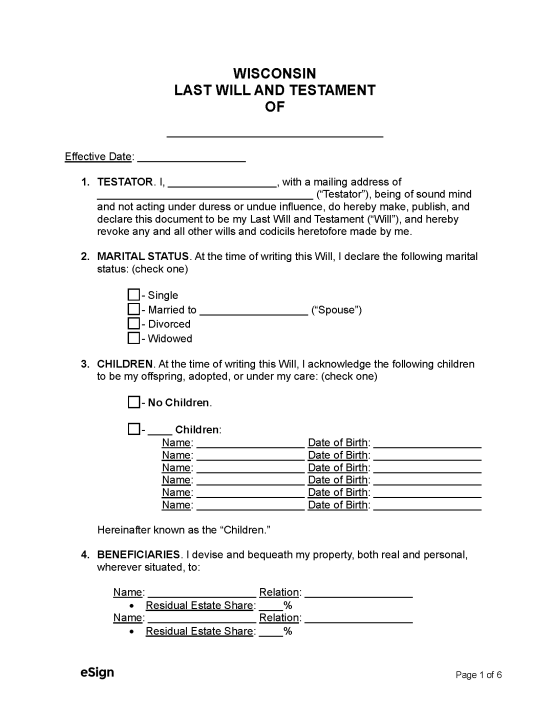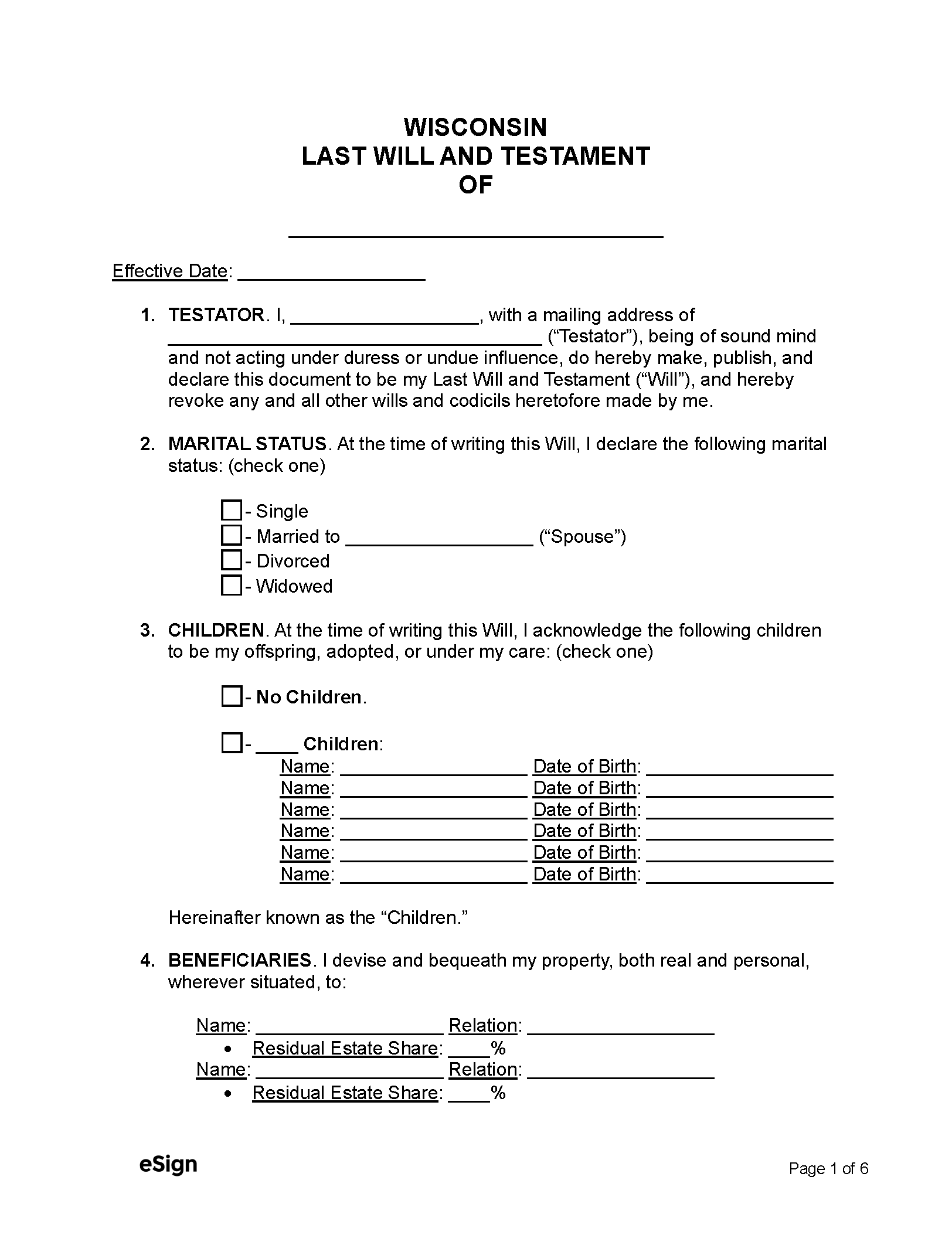State Laws
Any individual at least 18 years old and of sound mind may make a will.[1]
Holographic Will – Unless the individual who produced the will was a resident of a state where holographic wills are lawful upon signing the will, a holographic will is not valid in Wisconsin.[2]
Revocation – A will can be revoked in a number of ways:
- By creating a new will
- By physically destroying the will
- In part by terminating a marriage, revoking any distribution to the ex-spouse.[3]
Signing Requirements – To be valid, the will must be signed by the testator in the presence of two witnesses. Both witnesses must also sign the document.[4]
Probate Process in Wisconsin (8 Steps)
According to Wisconsin law, if the estate is not concluded within 18 months, the probate registrar will require the personal representative to explain why.[5] Many counties require estates to be closed within a 12-month period.
The following is meant to be a general overview of the probate process. It is recommended that executors/personal representatives consult with an attorney if they’re unsure of any step.
1. File Court Forms
If the total value of the decedent’s estate is $50,000 or less, probate proceedings can be avoided by filing the Transfer of Affidavit.[6]
In order to open informal probate proceedings in Wisconsin, certain documents must be filed with the Probate Registrar at the circuit court in the county where the testator passed away.[7] If the will has any contested issues, then formal probate administration proceedings may need to take place instead. The following documents are always required to begin informal probate:[8]
- The Original Will – The testator’s original will.
- Probate Claims Notice – Informs the Department of Health Services that the decedent died and discloses whether the deceased or their spouse received medical assistance.
- Application for Informal Administration (PR-1801) – Asks the court for informal administration.
- Waiver and Consent (PR-1803) – Signed by all interested persons to consent to the appointment of the personal representative and the informal administration of the estate.
- Notice to Creditors (PR-1804) – Used only if all interested parties sign the Waiver and Consent agree to appoint the personal representative, to use informal administration, and to waive the hearing.
- Notice Setting Time to Hear Application and Deadline for Filing Claims (PR-1805) – Used instead of the Notice to Creditors if all interested parties do not sign the Waiver and Consent form.
- Proof of Heirship (PR-1806) – Used to inform the court of the decedent’s heirs.
- Consent to Serve (PR-1807) – Signed by the personal representative to formally accept their duties.
- Statement of Informal Registration (PR-1808) – Filled out by the probate registrar and states that informal administration has been granted and that Domiciliary Letters will be given to the personal representative.
- Domiciliary Letters (PR-1810) – Used as proof that the personal representative is authorized by the court to act on behalf of the estate.
2. Wills Establishing a Trust (If Applicable)
If the last will and testament establishes a trust, then the two additional following forms must be filed with the court by the trustee:
Consent to Serve as Trustee (PR-1930)
Letters of Trust (PR-1829)
3. Appointment of Personal Representative
The individual who intends to act as personal representative may need to obtain consent from all interested parties before Domiciliary Letters are given. This can be done by having each interested party sign the Waiver and Consent (PR-1803) document. This form states that the interested party consents to the appointment of the individual as personal representative and that they waive notice requirements for any hearing to open the estate. The interested parties who sign this document state that they have been provided a list of all interested parties and either:
- A copy of the will, or,
- a notice regarding the bequest in the will.
If the personal representative obtains signatures from all interested parties, then the Notice to Creditors (PR-1804) may be completed, mailed to the creditors, and submitted to a local newspaper for publication. Once the Probate Registrar signs the document, the initial publication of the notice must take place within 15 days and run once a week for at least three consecutive weeks. The personal representative will obtain an Affidavit or Proof of Publication from the newspaper and submit it to the court.
If the personal representative does not get the signatures from all interested parties, they must file the Notice to Interested Persons and Time Limit for Filing Claims (PR-1805) instead of the Notice to Creditors (PR-1804). A copy of this notice must be mailed to creditors and published in a local newspaper once a week for at least three consecutive weeks, and the Affidavit or Proof of Publication must be delivered to the court.
Additionally, all interested individuals must be sent:
- a copy of the will
- a copy of the Application for Informal Administration (PR-1801)
- a copy of the Notice to Interested Persons and Time Limit for Filing Claims (PR-1805)
An Affidavit of Service (PR-1817) will then be completed and filed, indicating that the appropriate documents were provided to interested parties.
If there are no formal objections, the personal representative will then be appointed after the hearing date outlined in the Notice to Interested Persons.
4. Obtain a Personal Representative Bond (If Applicable)
The personal representative will usually be required to provide either a signature or surety bond to help protect the beneficiaries of the estate from any potential negligence or wrongdoing by the personal representative.[9] The bond ensures that the personal representative will act according to state laws and the wishes of the decedent. Some wills provide provisions waiving the requirement of a bond. If the court requires a signature bond, the form Signature Bond (PR-1809) should be filled out and submitted to the court.
5. Prepare Inventory and Estate Appraisal
Once the court provides the personal representative with Domiciliary Letters, they will have to prepare an inventory of the estate’s assets, including real estate, stocks, and other valuables. Inventory (PR-1811) must be filed along with the filing fee (0.2% of the assets) within six months of probate being opened. The inventory must show the property value, what is marital property, and any liens or encumbrances that may exist.[10] A copy of the inventory must be sent to all interested parties within five days after the inventory is filed with the court.[11]
The Affidavit of Service (PR-1817) must be submitted to the court as proof that a copy of the inventory was provided to the interested persons.
6. Pay Taxes and Debts
Any outstanding costs that the estate owes must be settled before anything can be distributed to the beneficiaries. The personal representative can check the Wisconsin Court System Website for potential claims on the estate. Upon payment, creditors must provide the personal representative with an Estate Receipt (PR-1815) form. If the personal representative wants to dispute a creditor’s claim, then they must file a Demand for Formal Proceedings (PR-1813) to have the court review the claim.
It is important that the personal representative ensures any taxes payable by the decedent or the estate are paid, as they could become personally liable for unpaid debts. The personal representative may file Form 5495 with the IRS to request a discharge of personal liability from any unpaid federal taxes.
If necessary, the personal representative has the authority to sell, mortgage, and lease any of the estate’s property in order to satisfy outstanding debts.[12]
It should be noted that there is no estate or inheritance tax in Wisconsin.
7. Distribute the Estate
8. Close the Estate
To close the estate, the personal representative must file certain documents with the court:
- Personal Representative’s Statement to Close Estate (PR-1816)
- Closing Certificate for Fiduciaries – will be provided after filing a Schedule CC with the Department of Revenue.
- Estate Receipt (PR-1815) – Must be provided by each heir/beneficiary/claimant stating any distributions they have received.
- Final Estate Account (PR-1814) – A record of what came and went out of the estate during probate. A copy of this must be given to each heir/beneficiary.
- Affidavit of Service (PR-1817) – Indicating a copy of the Final Estate Account(PR-1814) has been provided to all heirs/beneficiaries.
Most counties require the estate to be closed within 12 months of probate being opened; however, a Petition for Extention of Time (PR-1833) may be filed if the personal representative needs more time to settle the estate. Six months after filing the Personal Representative’s Statement to Close Estate (PR-1816), the personal representative will be relieved of their duties.

